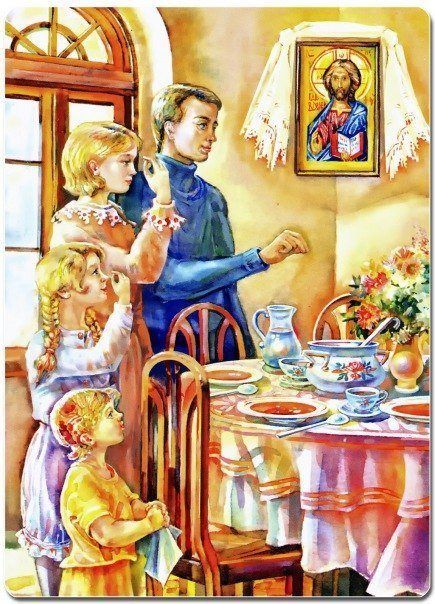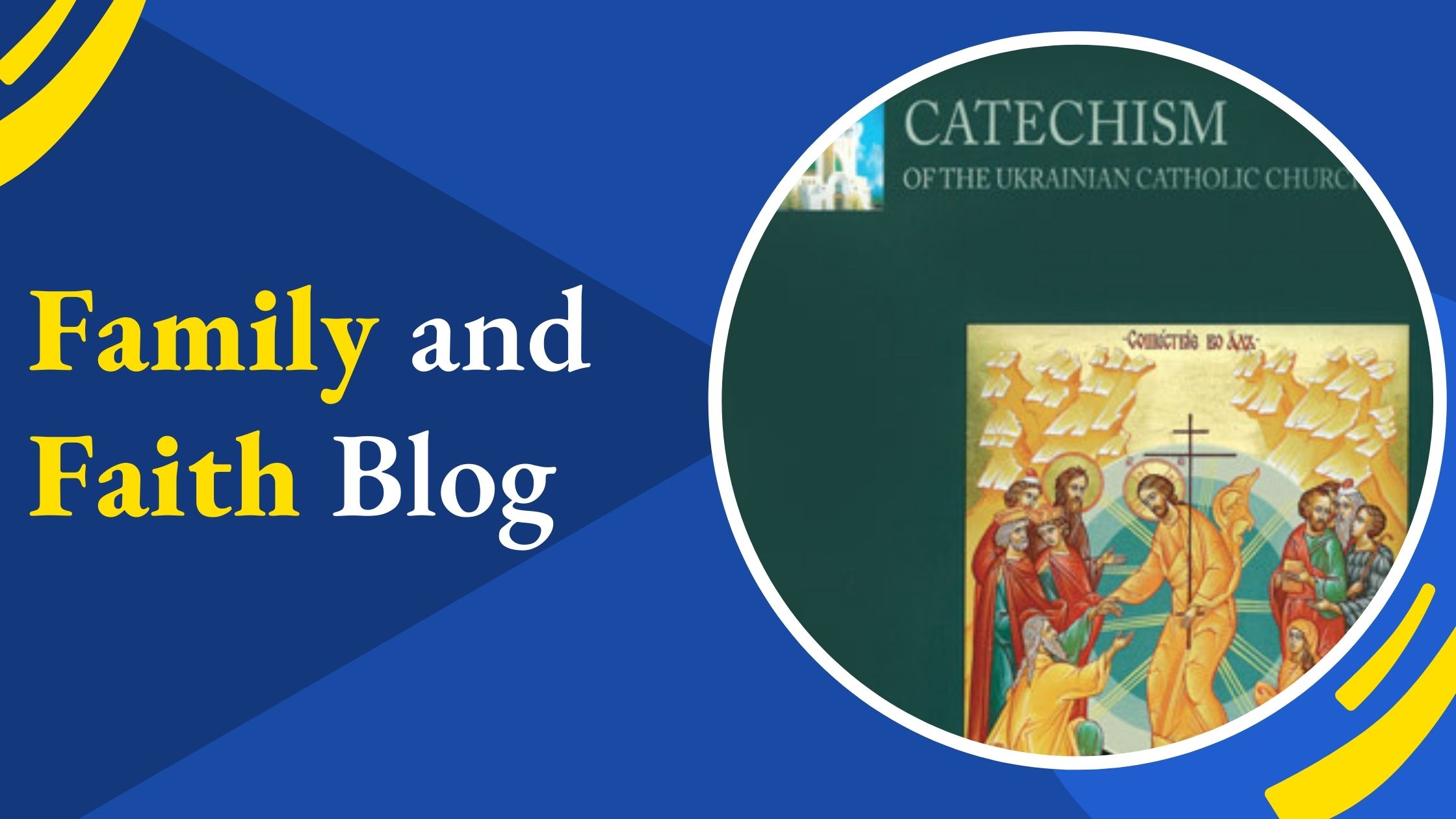This article comes from The Catechism of the Ukrainian Catholic Church on page 213. The Catechism of the Ukrainian Catholic Church Christ – Our Pascha is “both a profession and an explanation of our Church’s faith in the Triune God—Father, Son, and Holy Spirit. To read the digital version of the Catechism, click here or purchase a hardcopy here.
The Place of Family Prayer – The Domestic Church
A Christian family’s home is the place where members of the family share with God and among themselves the intimacy of love. The family is a community of love, which Saint Paul often calls the domestic church (see Rom 16:5; 1 Cor 16:19; Col 4:15). In this community, the husband and wife, the parents and children, liturgize: they render worship to God by serving one another. It is in the home that a person obtains his or her principal spiritual inheritance: knowledge of God, and respect for parents, the family hearth, the Church, and the earthly homeland.
Because the family has a calling to become a domestic church, the home in which the members of a family live becomes a church consecrated to achieving this vocation. This domestic temple is consecrated after it is built; it is then adorned with holy icons and blessed every year with Jordan water. As the parish church, the home is a place of prayer and the living out of the Holy Mystery of Marriage. Through the grace of the Holy Spirit received in the Holy Mystery of Marriage, the members of the family grow in the awareness of their vocation, in love for God and among themselves. Through their common faith, they achieve salvation.
The domestic church is a miniature community, united by blood and spiritual bonds. It is part of the great family of God, the Universal Church, which unites in one Christian family all who were born of God. This common birth makes them all brothers and sisters. The family as a domestic church is the primary cell of the Christian community, because it possesses the three principal ministries of the Universal Church: sharing the Good News, praying, and witnessing with one’s life. This means that the parents are the first evangelizers and educators of their children. The family is a community of prayer, conversing with God in everyday life, and as it builds new relationships grounded in evangelical love, the family is called to become a school of social solidarity.
The Icon Corner
The part of the home where icons are placed is called the icon corner. The name in English (as also the Ukrainian, pokuttia) derives from the custom of placing the icons in a corner (kut). For Christians, the corner of a house is a reminder of Jesus Christ, “the cornerstone.” Arranging such an icon corner in a home truly consecrates a place for God in the life of the family. Customarily there were three icons in such a corner: one of Jesus Christ, another of the Mother of God, and a third of Saint Nicholas. Christ, as the Head of the Church Body, is the model for the husband, the head of the family. The most holy Mother of God with the Child Jesus is the perfect model for the mother and the children. And Saint Nicholas is an example of compassion and hospitality.
In significant moments of family life, the parents bless their children with these icons. Before beginning the school year, or leaving home for military service, the children are blessed with the icon of Christ, and before marriage with the icon of the Mother of God. A family prays together and grows together in virtue in the presence of these icons. This corner is also the place for the main Christian books: Holy Scripture, a prayerbook, and a catechism.
Family Prayer
The family as a blessed community grows in the spouses’ personal communication with God and between themselves, that is, in prayer. Having arranged a place in their home for prayer (the icon corner), the family also sets aside time for prayer. According to Christian tradition, the family prays in the morning and in the evening, before a meal and after it. The Daily Prayers in the Horologion (or prayerbook) are an initial rule of prayer for a family. During family prayer, the children learn as they pray with their parents: they listen to the daily prayers and progressively absorb them. As they grow in common prayer, members of the family overcome the temptation to mutual estrangement and egoism. Family prayer prevents domestic quarrels and divorces; it reduces generational conflicts and teaches reconciliation and forgiveness.
The Christian family prays for the parents and family members (living and deceased). It asks God that children be educated and brought up well. It prays for spiritual and material benefits, and for the family’s earthly homeland. It also invokes God’s blessing on each day and especially difficult needs, so that in this way prayer “without ceasing” (see 1 Thes 5:17) will be achieved in the domestic church.

Family Rituals and Customs
The family—the domestic church—is a liturgical community of mutual, unselfish, and dedicated service to God and one another. Besides common prayer, the family liturgy includes a common reading of God’s Word and Christian literature, as well as blessings and thanksgiving for God’s gifts at common meals: “We give you thanks, O Christ our God, for you have satisfied us with your earthly good things. Do not deprive us of your heavenly kingdom, but as you came into the midst of your disciples, O Saviour, granting them peace, so also come to us and save us.” This is how we pray after the noon meal.
The solemnity of the family liturgy is particularly evident at the vigil suppers on the eve of Christmas and Theophany, and at the Paschal breakfast. The prayerful service of the family members is seen in the festive greeting and blessings that they exchange. For example, the father solemnly initiates the vigil supper by distributing the Christmas prosphora to each family member, and then the consecrated Jordan water. At Pascha (Easter), he also distributes a portion of the Paschal egg. The Christmas and Jordan carols, as well as the Easter songs that accompany the festive meal, are a majestic proclamation of the “great deeds of the Lord,” a joining to the ceaseless praise of the angels. Indeed, both common prayer and common meals are Christian family treasures.
A special form of marital love is the intimate relations of husband and wife. With God’s blessing, the two become one body, reflecting in the domestic church the mystery of Christ’s unity with his Church (see Eph 5:31-32). The joining of husband and wife is conducive to mutual love; it sanctifies them and opens them to conceiving new life. This is why the Church prays that God would “keep their marriage bed undefiled … that their common life be without flaw.” The sanctity of a daily family routine, the introduction of Christian rituals and customs into the household’s way of life, a liturgical spirit of domestic interaction— all this creates a solid foundation for the spirituality of family relations.
Reading Holy Scripture and Spiritual Literature in the Family
Daily reading of Scripture, especially the New Testament, should be joined organically to the practice of daily prayers. For in prayer we address God and in Holy Scripture God speaks to us. The Word of God helps parents to raise their children and helps children to respect their parents. Having understood this, the family will turn to Holy Scripture as to their best counsellor.
Spiritual literature, which includes the Lives of the Saints, the works of the Fathers of the Church, and ascetical literature, favours the establishment and development of one’s personality in the grace of the Holy Spirit. As one reads spiritual literature (e.g., the Patericon of the Kyivan-Caves Monastery, or the Confessions of Saint Augustine), one learns the experience of repentance and conversion. In the process of spiritual growth, a person must walk along the difficult path of ascesis—overcoming sinful habits and temptations, and struggling with passions. This path was described by the ascetics in their works (e.g., Saint John of the Ladder in his Ladder of Divine Ascent).
Through the centuries, the most accessible and beneficial work for family reading was and remains the Lives of the Saints. In their lives, the saints are shown in a variety of situations of life that they resolve because of the sanctity of their lives—a sanctity derived from cooperation with God’s grace. Every family member’s growth in sanctity, similar to the saints, is the principal aim of the family community.
Besides the reading of religious literature, the spiritual life of the domestic church is fostered by the viewing of religious films, television programs, religious sites on the internet, and by listening to religious radio programs and recordings on evangelical themes, as well as by reading Christian magazines. All this will help the contemporary family to find eternal spiritual treasures. It will also help them to draw responsibly and constructively from authentic spiritual and cultural springs, to react against a simplistic and coarse understanding of the family, as well as erroneous views of the human person, society, and the natural environment. Thus all that is sacred and magnificent in the church building will also have its place in the domestic church.
His Beatitude Sviatoslav Shevchuk comments on the importance of the domestic church.

